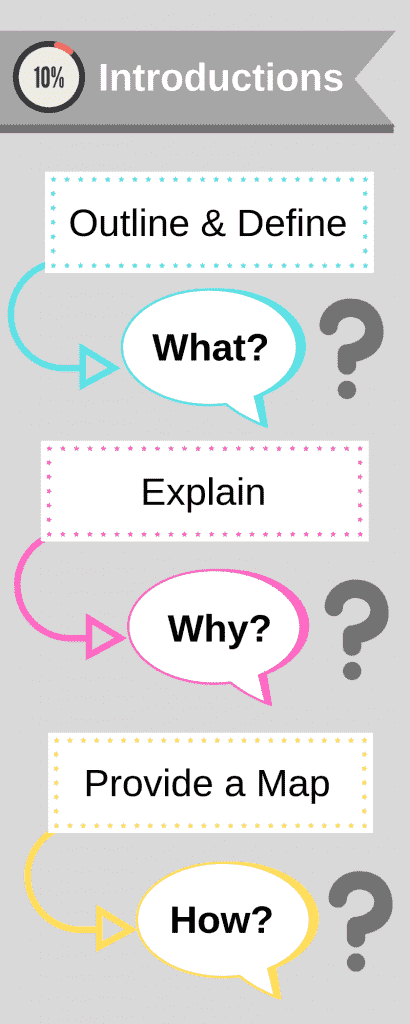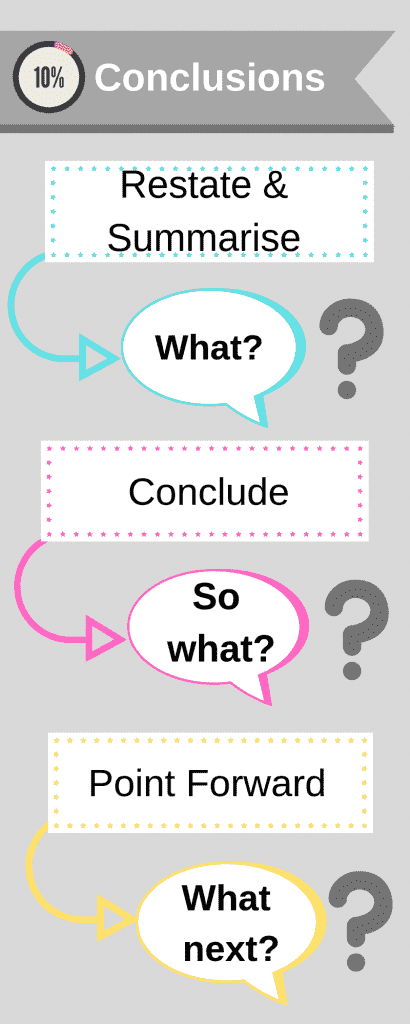Introductions and Conclusions
- Introductions and conclusions each take up around 10 % of your word count.
- In a longer piece of writing, they can be several paragraphs.
- You can find a useful summary of their key elements below.
What is an introduction?
An introduction sets the scene for the writing ahead. It does this by outlining the writing’s focus, explaining its importance and providing a map of the main points that will follow. In terms of length, introductions normally take up to 10% of your word count.
Introductions Trifold GuideTip
Some people write the introduction first to help focus the writing ahead. Others leave it until last when they are clearer about the content.
3 main elements in introductions
* Note: this is not a suggestion for structure.

1. Outline your topic, aims & define key terms
- What are the aims of this research?
- What is the context (social, political, economic, theoretical) to the topic?
- What are the key terms to be defined?
2. Explain the importance
- Why has this topic of interest/importance?
3. Provide a map of the writing
- How will this topic be covered?
- Which key aspects will be discussed?
- Has the research been limited to particular aspect(s)? Why?
- Which key practitioners or theories will be used?
- What might the essay seek to argue overall?
Example introduction adapted from Mann (2011):
What? This essay will discuss the work of Grayson Perry who has become a well-known craft artist within the last decade. The ceramist’s work often features controversial subject matter which relates to his life as a child, violent events in the world, and his experience as a transvestite man. Why? This subject has been chosen to answer the question due to an interest in ceramics and developing aspects of art that make a personal and social comment. How? Perry’s work will be analysed through specific examples chosen to represent different time periods. The intention is to gain an understanding of how an artist’s life can connect to their practice.
Example phrases for introductions
- This essay aims to …
- According to … (year, p. ), X can be defined as “ …”
- X is a major area of interest within … as …
- Up to now, little attention has been paid to …
- There is an ongoing debate surrounding …
- The research centres around examples from …
- These examples have been chosen as …
- One key theory utilised is …
- The main areas to be addressed in this report include …
What is a conclusion?
Conclusions also take up around 10 % of your word count. They restate your aims, summarise your findings and make a final conclusion in answer to your title. Additionally, you can sometimes consider the future of the topic in terms of research, actions or practice. Avoid introducing any new information such as extra evidence, which should feature within your main argument.
Conclusions Trifold GuideTip
Revisit your paragraphs; make a list of the key findings.
3 main elements in conclusions

* Note: this is not a suggestion for structure.
1. Restate your aims and summarise the findings
- What did the assignment aim to cover?
- What were the key findings?
- What is the significance of these findings?
2. Make a final conclusion
- So what can be argued overall in relation to the title?
- So what can be learnt from this?
- Were there any questions left unanswered?
3. Point forward to the future (optional)
- What further research or actions could be carried out next?
- How could this research influence my practice?
Example conclusion adapted from Mann (2011):
What? This essay aimed to analyse the connection between Greyson Perry’s ceramics and his life. Two emerging themes included the use of Perry’s experiences as a child and as a transvestite man living within the contemporary world to make a provocative comment on innocence and violence. While working with a traditional form of art, Perry challenges the viewers’ perceptions about his chosen medium of ceramics and the functions of art within a postmodern era. So what? Overall, his symbolically charged imagery leaves the viewer wanting more knowledge about his life, and this provides a greater appreciation and understanding of his work. Now what? In terms of further research, it would be interesting to explore how Perry utilises other mediums such as textiles.
Phrases for conclusions
- This essay discussed the reasons for …
- This report aimed to …
- The research shows that …
- The most significant finding to emerge is that…
- A question for future research is …
Sources consulted
- Godfrey, J. (2013) The student phrase book. Basingstoke: Palgrave Macmillan.
- Godwin, J. (2014) Planning your essay. Basingstoke: Palgrave Macmillan.
- Manchester University (2016) Academic phrase bank. Available at: www.phrasebank.manchester.ac.uk (Accessed: 25 January 2019).
- Mann, S. (2011) Study skills for art design and media students. Harlow: Pearson.
- Mcmillan, K. and Weyers, J. (2011) How to write essays and assignments. 2nd Edition.. Harlow: Pearson.
